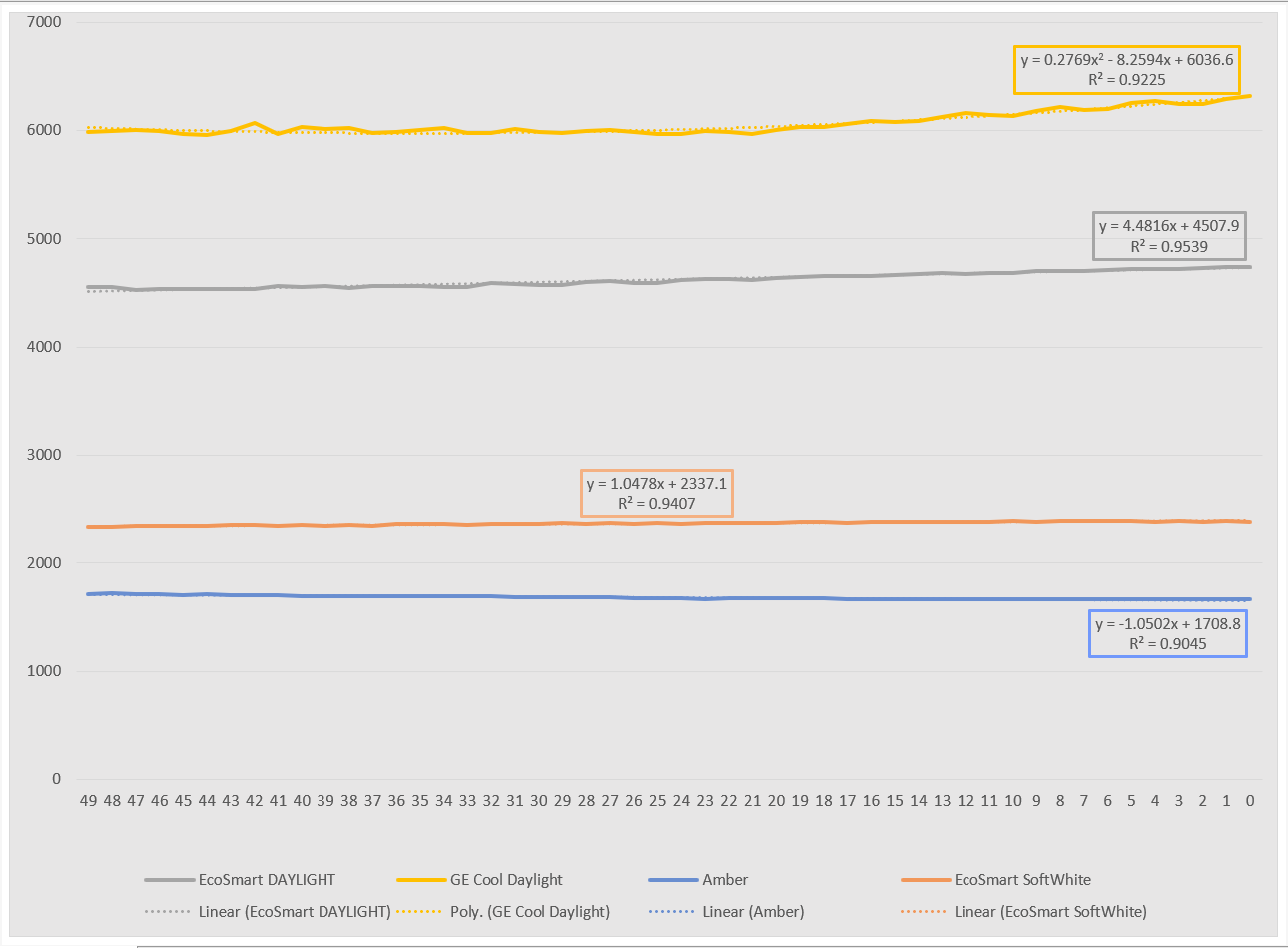The previous log used the light sensor to measure light output levels relative to input power. This entry will review how the effective color temperature is calculated using the RGB sensor. This value was then measured over a range of power settings to determine not only the ability to easily record color temperature, but the fluctuation of color temperature relative to power input (spoiler alert: for most inexpensive dimmable LEDs color temperature typically does not!).
The color temperature readings were taken without prior calibration of the response of the associated sensor (BH1749NUC) using known inputs. However, even without that step the good news was that calculated color temperatures were generally in line, albeit around 10% lower, than the values claimed by the manufacturers. Though a calibration step may have likely improved the ability of the sensor to produce correlated color temperature values aligned with the manufacturer stated values, the fact that calculated values came close on the first try proved encouraging enough to continue on with the next steps.
The process for performing this calculation is to convert the RGB values to XYZ values (each part of a standardized color space) and from there the values can be mapped to a coordinate space for color temperature. A sample of different light sources in addition to the lamps planned for the prototype were used to provide multiple unique inputs to the color temperature calculation. The results at maximum power are tabulated below:
| Lamp | Labeled Color Temp (K) | Calc. Color Temp (K) |
| Amber LED | 2000K | 1745K |
| EcoSmart Soft White | 2700K | 2387K |
| EcoSmart Daylight | 5000K | 4742K |
| GE Cool Daylight | 6500K | 6336K |
Without calibration the values calculated are already close to the rated/expected values. Note that there is often some natural variation between the rated manufacturer values and independently measured values given variances in the way color temperatures are measured. Some more detail in underlying differences will become apparent as we examine values recorded from the spectrometer. To be clear, calculating color temperature from RGB readings is an intentional simplification. However, using the values from the spectrometer would not necessarily be any more meaningful relative to manufacturer values without delving into the industry-specific measurement standards defined for this process. We'd certainly welcome any input from those who might have some familiarity with these specifications!
So having achieved relative success in approximating color temperature readings with the RGB sensor, we then proceeded to measure those values relative to power levels. And the good news is that for the selected, commodity dimmable LED lamps they proved fairly stable across a range of power levels. We did have some difficulty previously with lamps supporting differing minimum power levels, so we attempted to account for that here by starting with a higher minimum power level for the tested range to produce meaningful values. Note that this means the range covered below represents output levels starting around 2-7% of maximum for the range of lamps. Though wider ranges could be reported we'd have to customize the output for each of the lamps.
Note how for most of the examples a fairly flat, linear color temperature is recorded over the minimum (left) to maximum output (right) ranges. For the warmer range of lamps the increase in color temperature over the range of the lamp represents a shift of around 2% of the rated value. For the cooler lamps this increases to around 5%.
Overall this stability should make combining these sources at different power levels to achieve a customized final output color temperature relatively easy to predict. These findings appear to recommend the use of such simple, dimmable LED lamps over more internally complex sources with dim to warm features such as those mentioned in a prior post. This relative stability is significant when compared to more variable sources, a couple of which we'll cover in our next post!
 |
| Illustrated above are the calculated color temperature for a given power level as measured for each of the target lamps associated with the prototype. |
 Jon
Jon
Discussions
Become a Hackaday.io Member
Create an account to leave a comment. Already have an account? Log In.
Here is a chipset vendor's application notes for their (competing) RGB sensor:
https://www.maximintegrated.com/en/design/technical-documents/app-notes/5/5410.html
Are you sure? yes | no